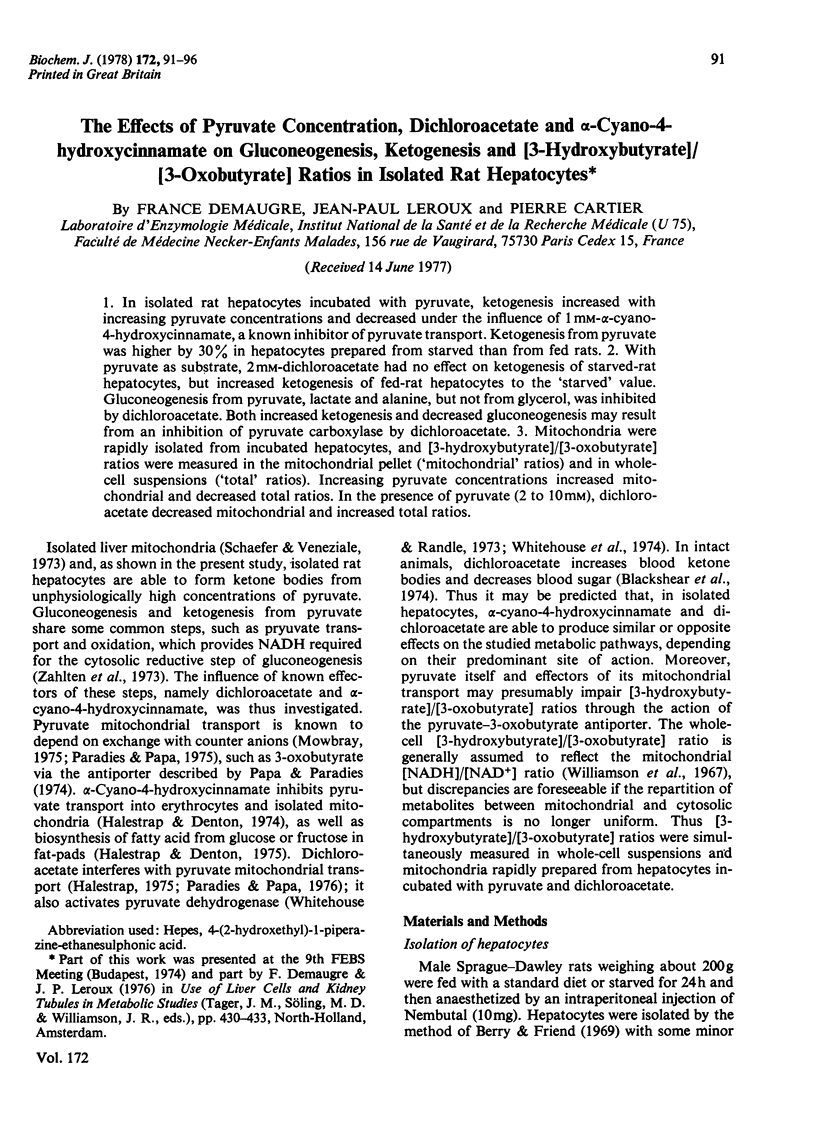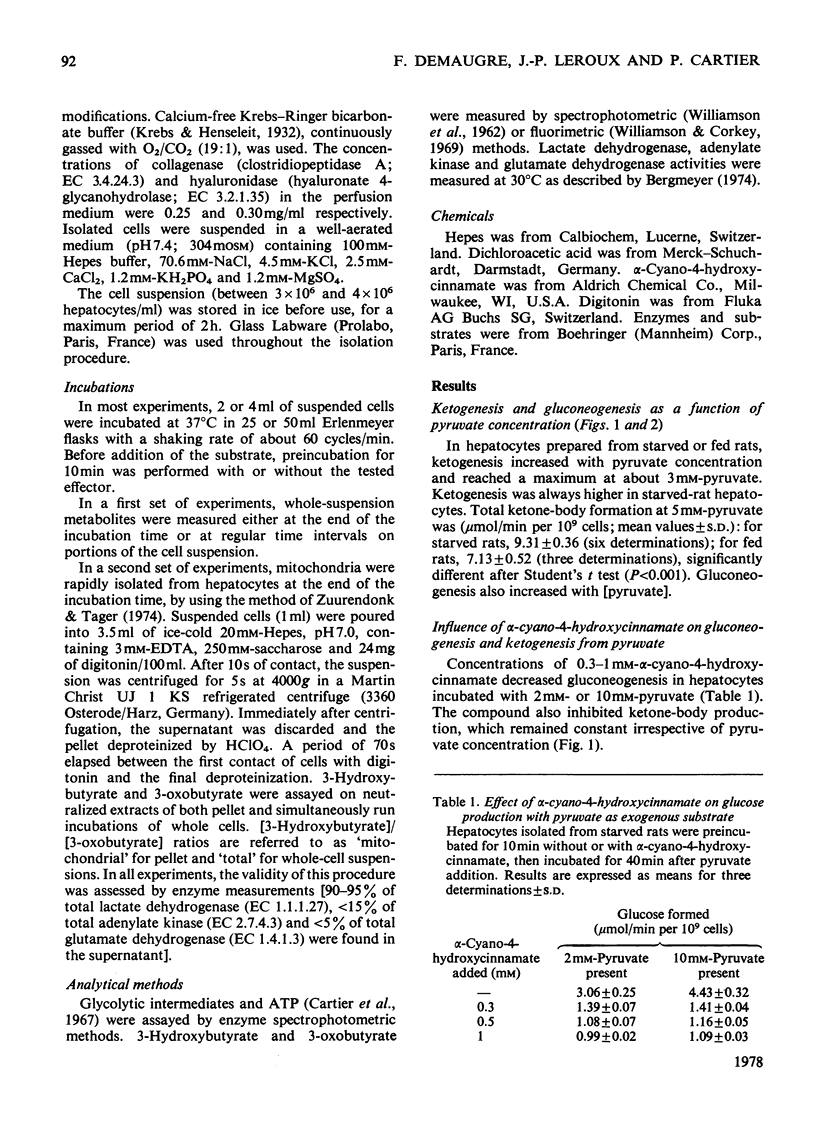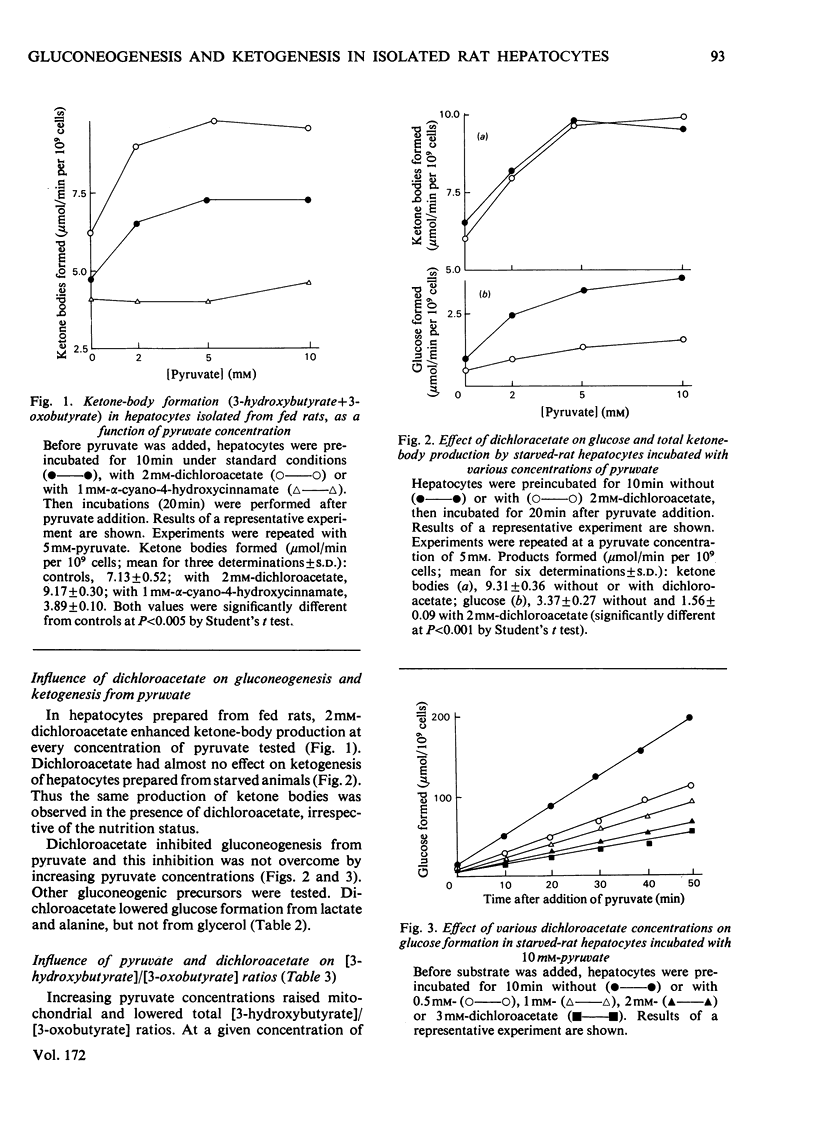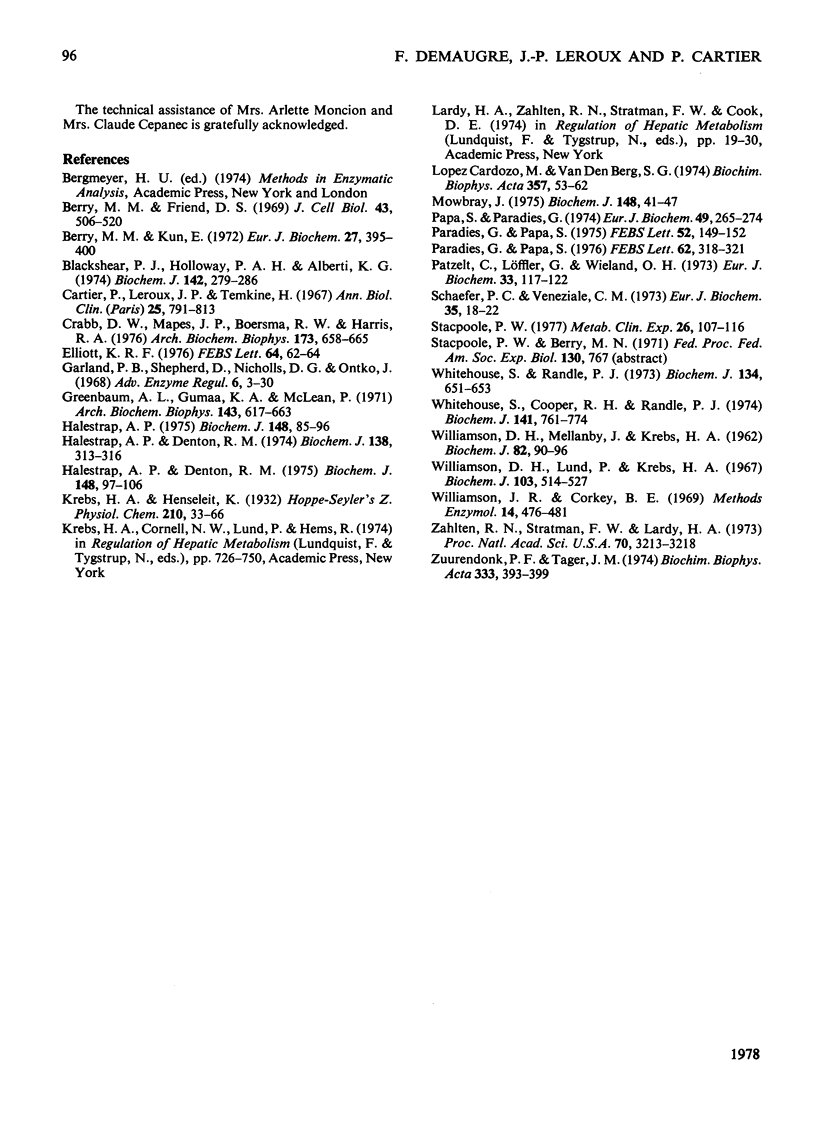Abstract
1. In isolated rat hepatocytes incubated with pyruvate, ketogenesis increased with increasing pyruvate concentrations and decreased under the influence of 1 mM-alpha-cyano-4-hydroxycinnamate, a known inhibitor of pyruvate transport. Ketogenesis from pyruvate was higher by 30% in hepatocytes prepared from starved than from fed rats. 2. With pyruvate as substrate, 2 mM-dichloroacetate had no effect on ketogenesis of starved-rat hepatocytes, but increased ketogenesis of fed-rat hepatocytes to the 'starved' value. Gluconeogenesis from pyruvate, lactate and alanine, but not from glycerol, was inhibited by dichloroacetate. Both increased ketogenesis and decreased gluconeogenesis may result from an inhibition of pyruvate carboxylase by dichloroacetate. 3. Mitochondria were rapidly isolated from incubated hepatocytes, and [3-hydroxybutyrate]/[3-oxobutyrate] ratios were measured in the mitochondrial pellet ('mitochondrial' ratios) and in whole-cell suspensions ('total' ratios). Increasing pyruvate concentrations increased mitochondrial and decreased total ratios. In the presence of pyruvate (2 to 10 mM), dichloroacetate decreased mitochondrial and increased total ratios.
Full text
PDF





Selected References
These references are in PubMed. This may not be the complete list of references from this article.
- Berry M. N., Friend D. S. High-yield preparation of isolated rat liver parenchymal cells: a biochemical and fine structural study. J Cell Biol. 1969 Dec;43(3):506–520. doi: 10.1083/jcb.43.3.506. [DOI] [PMC free article] [PubMed] [Google Scholar]
- Berry M. N., Kun E. Rate-limiting steps of gluconeogenesis in liver cells as determined with the aid of fluoro-dicarboxylic acids. Eur J Biochem. 1972 May 23;27(2):395–400. doi: 10.1111/j.1432-1033.1972.tb01850.x. [DOI] [PubMed] [Google Scholar]
- Blackshear P. J., Holloway P. A., Alberti K. G. The metabolic effects of sodium dichloroacetate in the starved rat. Biochem J. 1974 Aug;142(2):279–286. doi: 10.1042/bj1420279. [DOI] [PMC free article] [PubMed] [Google Scholar]
- Cartier P., Leroux J. P., Temkine H. Techniques de dosage des intermédiaires de la glycolyse dans les tissus. Ann Biol Clin (Paris) 1967 Jul-Sep;25(7):791–813. [PubMed] [Google Scholar]
- Crabb D. W., Mapes J. P., Boersma R. W., Harris R. A. Effect of dichloroacetate on carbohydrate and lipid metabolism of isolated hepatocytes. Arch Biochem Biophys. 1976 Apr;173(2):658–665. doi: 10.1016/0003-9861(76)90303-9. [DOI] [PubMed] [Google Scholar]
- Elliott K. R. The effects of gelatin and bovine serum albumin on Ca2+ stimulation of gluconeogenesis in isolalted rat hepatocytes. FEBS Lett. 1976 Apr 15;64(1):62–64. doi: 10.1016/0014-5793(76)80249-9. [DOI] [PubMed] [Google Scholar]
- Garland P. B., Shepherd D., Nicholls D. G., Ontko J. Energy-dependent control of the tricarboxylic acid cycle by fatty acid oxidation in rat liver mitochondria. Adv Enzyme Regul. 1968;6:3–30. doi: 10.1016/0065-2571(68)90005-8. [DOI] [PubMed] [Google Scholar]
- Greenbaum A. L., Gumaa K. A., McLean P. The distribution of hepatic metabolites and the control of the pathways of carbohydrate metabolism in animals of different dietary and hormonal status. Arch Biochem Biophys. 1971 Apr;143(2):617–663. doi: 10.1016/0003-9861(71)90247-5. [DOI] [PubMed] [Google Scholar]
- Halestrap A. P., Denton R. M. Specific inhibition of pyruvate transport in rat liver mitochondria and human erythrocytes by alpha-cyano-4-hydroxycinnamate. Biochem J. 1974 Feb;138(2):313–316. doi: 10.1042/bj1380313. [DOI] [PMC free article] [PubMed] [Google Scholar]
- Halestrap A. P., Denton R. M. The specificity and metabolic implications of the inhibition of pyruvate transport in isolated mitochondria and intact tissue preparations by alpha-Cyano-4-hydroxycinnamate and related compounds. Biochem J. 1975 Apr;148(1):97–106. doi: 10.1042/bj1480097. [DOI] [PMC free article] [PubMed] [Google Scholar]
- Halestrap A. P. The mitochondrial pyruvate carrier. Kinetics and specificity for substrates and inhibitors. Biochem J. 1975 Apr;148(1):85–96. doi: 10.1042/bj1480085. [DOI] [PMC free article] [PubMed] [Google Scholar]
- Lopes-Cardozo M., van den Bergh S. G. Ketogenesis in isolated rat liver mitochondria. III. Relationship with the rate of beta-oxidation. Biochim Biophys Acta. 1974 Jul 25;357(1):53–62. doi: 10.1016/0005-2728(74)90111-x. [DOI] [PubMed] [Google Scholar]
- Mowbray J. A mitochondrial monocarboxylate transporter in rat liver and heart and its possible function in cell control. Biochem J. 1975 Apr;148(1):41–47. doi: 10.1042/bj1480041. [DOI] [PMC free article] [PubMed] [Google Scholar]
- Papa S., Paradies G. On the mechanism of translocation of pyruvate and other monocarboxylic acids in rat-liver mitochondria. Eur J Biochem. 1974 Nov 1;49(1):265–274. doi: 10.1111/j.1432-1033.1974.tb03831.x. [DOI] [PubMed] [Google Scholar]
- Paradies G., Papa S. Substrate regulation of the pyruvate-transporting system in rat liver mitochondria. FEBS Lett. 1976 Mar 1;62(3):318–321. doi: 10.1016/0014-5793(76)80084-1. [DOI] [PubMed] [Google Scholar]
- Paradies G., Papa S. The transport of monocarboxylic oxoacids in rat liver mitochondria. FEBS Lett. 1975 Mar 15;52(1):149–152. doi: 10.1016/0014-5793(75)80659-4. [DOI] [PubMed] [Google Scholar]
- Patzelt C., Löffler G., Wieland O. H. Interconversion of pyruvate dehydrogenase in the isolated perfused rat liver. Eur J Biochem. 1973 Feb 15;33(1):117–122. doi: 10.1111/j.1432-1033.1973.tb02662.x. [DOI] [PubMed] [Google Scholar]
- Schaefer P. C., Veneziale C. M. Regulation of pyruvate metabolism in rat-liver mitochondria by K + and P i . Eur J Biochem. 1973 May;35(1):18–22. doi: 10.1111/j.1432-1033.1973.tb02804.x. [DOI] [PubMed] [Google Scholar]
- Stacpoole P. W. Effect of dichloroacetate on gluconeogenesis in isolated rat hepatocytes. Metabolism. 1977 Feb;26(2):107–116. doi: 10.1016/0026-0495(77)90046-4. [DOI] [PubMed] [Google Scholar]
- WILLIAMSON D. H., MELLANBY J., KREBS H. A. Enzymic determination of D(-)-beta-hydroxybutyric acid and acetoacetic acid in blood. Biochem J. 1962 Jan;82:90–96. doi: 10.1042/bj0820090. [DOI] [PMC free article] [PubMed] [Google Scholar]
- Whitehouse S., Cooper R. H., Randle P. J. Mechanism of activation of pyruvate dehydrogenase by dichloroacetate and other halogenated carboxylic acids. Biochem J. 1974 Sep;141(3):761–774. doi: 10.1042/bj1410761. [DOI] [PMC free article] [PubMed] [Google Scholar]
- Whitehouse S., Randle P. J. Activation of pyruvate dehydrogenase in perfused rat heart by dichloroacetate (Short Communication). Biochem J. 1973 Jun;134(2):651–653. doi: 10.1042/bj1340651. [DOI] [PMC free article] [PubMed] [Google Scholar]
- Williamson D. H., Lund P., Krebs H. A. The redox state of free nicotinamide-adenine dinucleotide in the cytoplasm and mitochondria of rat liver. Biochem J. 1967 May;103(2):514–527. doi: 10.1042/bj1030514. [DOI] [PMC free article] [PubMed] [Google Scholar]
- Zahlten R. N., Stratman F. W., Lardy H. A. Regulation of glucose synthesis in hormone-sensitive isolated rat hepatocytes. Proc Natl Acad Sci U S A. 1973 Nov;70(11):3213–3218. doi: 10.1073/pnas.70.11.3213. [DOI] [PMC free article] [PubMed] [Google Scholar]


